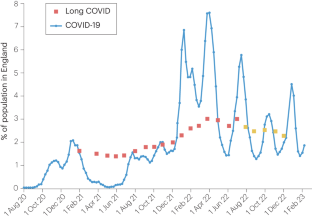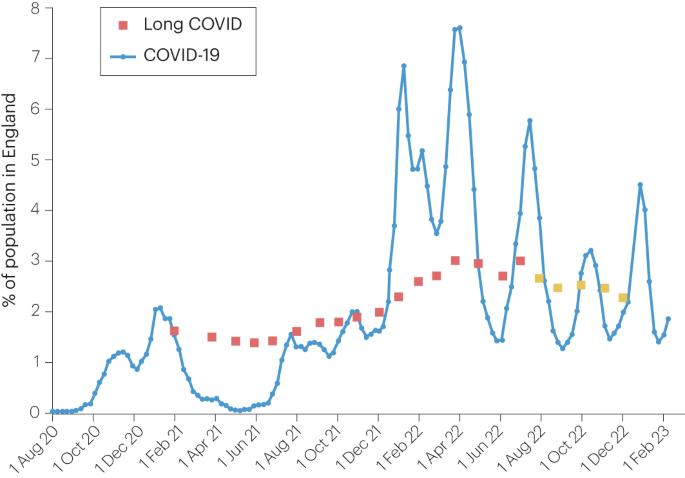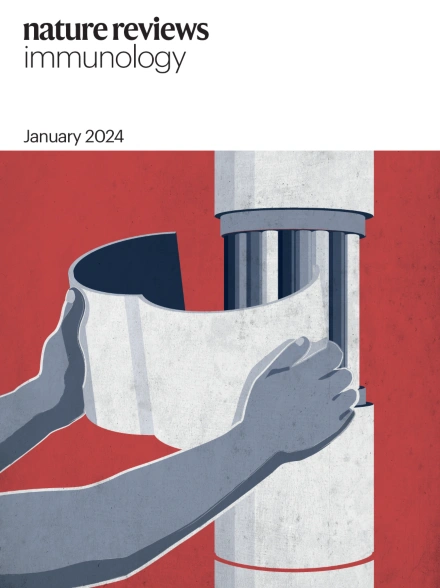长期新冠肺炎的免疫学。
IF 67.7
1区 医学
Q1 IMMUNOLOGY
引用次数: 23
摘要
长期新冠肺炎是患者创造的疾病实体术语,在患有新冠肺炎的患者中,无论是无症状的、轻度的还是重度的,很大一部分患者都会出现持续症状。估计数字各不相同,但假设在全球所有患有新冠肺炎的人中,至少有10%患有长期新冠肺炎。疾病负担从轻微症状到严重残疾,其规模使这成为一个巨大的、新的医疗挑战。长期新冠肺炎可能会分为几个或多或少具有潜在不同致病途径的离散实体。不断演变的症状列表是广泛的、多器官的、多系统的和复发缓解的,包括疲劳、呼吸困难、神经认知影响和自主神经功能障碍。在长期新冠肺炎患者的嗅球、大脑、心脏、肺部和其他部位观察到一系列放射学异常。一些身体部位表明存在微斑块;这些和其他高凝状态的血液标志物暗示了内皮激活和凝血异常的可能作用。已经发现了多种自身抗体(AAB)特异性,但尚未与症状群达成明确共识或相关性。有证据支持持续的严重急性呼吸系统综合征冠状病毒2型宿主的作用和/或爱泼斯坦-巴尔病毒重新激活的影响,并有证据表明免疫亚群的变化导致了广泛的免疫干扰。因此,目前的情况是,长期新冠肺炎的免疫病理病因图趋于一致,尽管目前还没有足够的数据进行机制合成或完全告知治疗途径。本文章由计算机程序翻译,如有差异,请以英文原文为准。


The immunology of long COVID
Long COVID is the patient-coined term for the disease entity whereby persistent symptoms ensue in a significant proportion of those who have had COVID-19, whether asymptomatic, mild or severe. Estimated numbers vary but the assumption is that, of all those who had COVID-19 globally, at least 10% have long COVID. The disease burden spans from mild symptoms to profound disability, the scale making this a huge, new health-care challenge. Long COVID will likely be stratified into several more or less discrete entities with potentially distinct pathogenic pathways. The evolving symptom list is extensive, multi-organ, multisystem and relapsing–remitting, including fatigue, breathlessness, neurocognitive effects and dysautonomia. A range of radiological abnormalities in the olfactory bulb, brain, heart, lung and other sites have been observed in individuals with long COVID. Some body sites indicate the presence of microclots; these and other blood markers of hypercoagulation implicate a likely role of endothelial activation and clotting abnormalities. Diverse auto-antibody (AAB) specificities have been found, as yet without a clear consensus or correlation with symptom clusters. There is support for a role of persistent SARS-CoV-2 reservoirs and/or an effect of Epstein–Barr virus reactivation, and evidence from immune subset changes for broad immune perturbation. Thus, the current picture is one of convergence towards a map of an immunopathogenic aetiology of long COVID, though as yet with insufficient data for a mechanistic synthesis or to fully inform therapeutic pathways. SARS-CoV-2 infection can lead to a diverse array of chronic symptoms, collectively termed ‘long COVID’. In this Review, Altmann and colleagues explore current thinking about the pathophysiology of long COVID and discuss potential immunological mechanisms.
求助全文
通过发布文献求助,成功后即可免费获取论文全文。
去求助
来源期刊

Nature Reviews Immunology
医学-免疫学
CiteScore
93.40
自引率
0.40%
发文量
131
审稿时长
6-12 weeks
期刊介绍:
Nature Reviews Immunology is a journal that provides comprehensive coverage of all areas of immunology, including fundamental mechanisms and applied aspects. It has two international standard serial numbers (ISSN): 1474-1733 for print and 1474-1741 for online. In addition to review articles, the journal also features recent developments and new primary papers in the field, as well as reflections on influential people, papers, and events in the development of immunology. The subjects covered by Nature Reviews Immunology include allergy and asthma, autoimmunity, antigen processing and presentation, apoptosis and cell death, chemokines and chemokine receptors, cytokines and cytokine receptors, development and function of cells of the immune system, haematopoiesis, infection and immunity, immunotherapy, innate immunity, mucosal immunology and the microbiota, regulation of the immune response, signalling in the immune system, transplantation, tumour immunology and immunotherapy, and vaccine development.
 求助内容:
求助内容: 应助结果提醒方式:
应助结果提醒方式:


